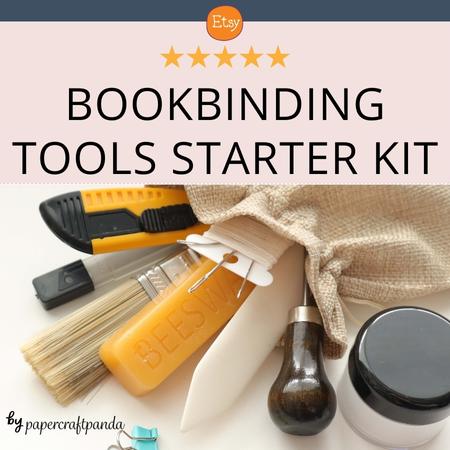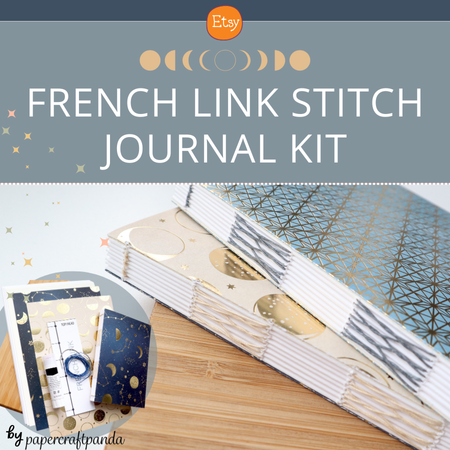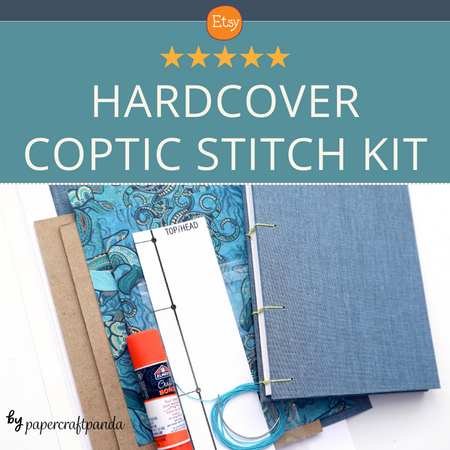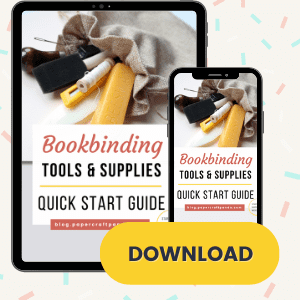A B C
Awl
A tool used in bookbinding to pierce paper, creating an opening through which thread can be sewn.
Back saw
A special saw with fine teeth used to cut sewing stations into the spine of a book block. The book block is usually clamped tightly in a finishing press.
Backing boards
A pair of wedge shaped boards used in the process of rounding or shaping a spine so there is a 90 or 45 degree angle at the shoulder (called “backing”).
Backing hammer
A special tool used to round and back the spine of a book. Backing hammers feature a rounded head and notchless claw at one end.
Backing iron
A pair of wedge shaped boards with a steel faced beveled edges used to apply pressure juut under the spine of a text block. Backing irons are used to “convert” a lying press to a backing press.
Bag weights
Bags filled with beans, rice, shot or other lightly weighted material. Used to gently press adhesive bindings between steps. Generally available in various shapes, sizes and soft materials.
Band nipper
Plier-like tools with broad, flat jaws, used to pinch or “nip” leather or cloth around raised bands during the book covering process. These are also used to straighten book bands that have been sewn on raised cords.
Beeswax
A cake of wax, typically purchased as a small block, used for waxing thread prior to sewing. Beeswax is naturally produced, organic, with a neutral pH and a high melting point. These characteristics make it desirable for use in book making.
Binder's board
The material used for the front and back boards of a book. Also referred to as “Davey” or book board. Available in various thicknesses.
Binder's shears
Premium quality, solid steel scissors that are extremely sharp and hold a tight cutting edge right to the tip.
Binder clips
A piece of spring-loaded bent steel with two closed loops used to secure signatures without marring paper. Binder clips are available in many different sizes.
Book block
Also called a text block, these are pages of a book that have been sewn or glued together into a single unit.
Bone folder
A semi-flat, polished tool traditionally made of bone. Used to score, flatten folds or smooth paper in a single stroke without marring delicate papers.
Book board
The material used for the front and back boards of a book. Referred to as “Davey” or “binder’s” board. Available in various thicknesses.
Book cloth
Specially prepared covering material for book covers. Strong, long-lasting and protective. Depending on the sizing method, some may be water resistant and/or waterproof.
Book press
A book press (also: bookpress) is a piece of equipment used by book makers to apply pressure to a book (or various parts of a book) throughout the binding process.
Book plough
A piece of equipment with a sharp blade used to trim the edges of a book. A plough usually comes with a tub where trimmings can be captured as they fall away.
Brass weights
Solid blocks made of machined brass with very slightly rounded edges to prevent snags, dents or other damage to valuable materials. Used to press books and other materials. Available in various lengths, widths and heights.
Chip board
An all-purpose craft board made from waste wood. May be either acidic or acid-free depending on the manufacturer.
Cold wheat paste
Pre-cooked wheat paste which has been dehydrated into a fine powder. Cold water is whisked into the powder to reactivate the paste, making it a time-friendly alternative to traditional wheat paste.
Combination press
A piece of equipment that combines the functionality of a standing press, lying press, and plough in a single unit.
Cord, Twine
A heavy, high quality, unwaxed, unbleached and minimally processed cord made of twisted linen threads. These cords provide spinal support when sewn perpendicular to the spine using a sewing frame.
Corner jig
A tool used to create even, consistently shaped corners on the case or covers of a book.
Crash
Material used to cover the spine, providing added reinforcement. Typically made of starched linen material. Given the global. nature of bookbinding, the mull may also be referred to by one of the following names: Mull, Muslin, Super, Tarlatan.
D E F
Darning needle
This is a large, straight needle with an eye big enough to fit embroidery floss, yarn and other threads. The tip is usually blunt. The name takes itself from “darning,” which is the process of mending a hole in knitted material.
Davey board
Named after the company that manufactured it (The Davey Company (Davey Est 1842)). This is a superior quality binder’s board created using a single ply wet lap construction. The board’s high density makes it difficult to break and provides a high corner crush resistance.
Daylight space
The amount of light visible through a book press when fully opened. More daylight space will allow more books to be pressed at one time.
End bands
Elements placed at the head and tail of a book, historically used to reinforce the spine. Today, end bands may be hand-sewn or manufactured and serve more of a decorative purpose.
Endsheets
These are the papers at the start and end of the book which provide a pause or introduction before the text begins. They are never glued to the cover (those are called endpapers). Artistic book makers like to think of these as the “curtains that rise” before the real show begins.
Endpapers
These are papers at the start and end of the book, usually decorative, which are pasted down onto the covers in order to hold the text block in place while supporting the hinge.
Finishing press
A piece of equipment used to clamp a book in place while “finishing” activities (endband sewing, foredge decoration, lettering, etc.) take place.
Flush
In bookbinding, when all pages share uniform alignment to one or more edges of a book.
Folio
A single sheet folded in half to create a signature of four pages and two leaves.
Foredge
The front edge of a book, parallel yet opposite to the spine.
G H I
Gathering
An assembled group of folded signatures, in the proper order, ready for binding.
Gauge
A measurement of the final thickness of thread once woven together.
Glue brush
A brush specifically used to apply adhesive to books. Adhesives may be water-based, plant-based or synethetic. Usually made with synthetic or natural bristles. Various sizes allow for many different types and styles of application.
Grain direction
In paper, grain direction refers to the orientation of settled paper fibers once water is removed.
Gutter
The white space or inner margin visible when a book is opened to any page. If the book is opened to a signature, sewing thread may be visible running along the gutter.
Headband
Another word used to describe endbands. These are sewn, wrapped or beaded thread decorations at the head and tail of a book.
Head
The top a book when standing upright.
Hinge
The flexible area between a book’s covers and spine, allowing the book to open and close easily.
J K L
Japanese screw punch
A tool used to pierce or punch holes of various sizes in paper or other material. The tool contains a brass chuck used to swap out metal tips of various diameters ranging from 1.0-4.0 mm. Downward pressure is applied, spinning the bit within the chuck and cutting the material in a single motion.
Job backer
A large piece of cast iron equipment specifically used for rounding and backing the spine of a book. Job backers are rare today, so bookbinders will often use backing boards in a lying press to simulate functionality.
Jog
The act of knocking a folded signature or gathering upon a solid surface in order to level all papers to one edge (usually the head).
Kettle
The sewing station at the head and tail of a book created by linking the previous signature with the next in a sewn connection.
Linen thread
Made from 100% cotton fiber, linen thread is considered to be the strongest and highest quality sewing thread used for bookbinding.
Available in various thicknesses.
Leaf
A sheet or set of two pages, folded back to back.
Linen tapes
A quality linen (70%) and cotton (30%) blend material used as a sewn support in bookbinding. Referred to as “tapes” due to their shape, they are available in widths from 3mm (1/4″) to 19mm (3/4″).
M N O
Moulding saw
Another term to describe a back saw. Used to cut sewing stations into the spine of a book block while clamped firmly in a finishing press.
Mull
Material used to cover the spine, providing added reinforcement. Typically made of starched linen material. Given the global. nature of bookbinding, the mull may also be referred to by one of the following names: Muslin, Crash, Super, Tarlatan.
Muslin
Material used to cover the spine, providing added reinforcement. Typically made of starched linen material. Given the global. nature of bookbinding, the mull may also be referred to by one of the following names: Mull, Crash, Super, Tarlatan.
Needle, curved
Curved needles are traditionally used to create Coptic or Ethiopian binding stitches. They’re sturdy with a polished eye to prevent wear on thread. The needle shank is often thin or thick. All curved needles have a sharp point.
Needle, straight
Used in traditional bookbinding, straight needles are sturdy with a polished eye to prevent wear on thread. The needle eye comes in various sizes and the needle point may be sharp or blunt.
Nipping press
A type of book press used by binders to apply quick, even pressure to a book (or parts of a book) during the binding process. Nipping presses are generally easier to open and close, making them a great choice for short, quick bursts of even pressure.
Octavo
Another word for folio. A folded sheet to create a signature of four pages with two leaves.
Olfa knife
A light duty retractable utility knife for use in cutting paper and thin board. Usually made of carbon steel with snap off blades to allow for continuously sharp edges.
P Q R
Packing
The process of layering thread around cords or thongs to fill in gaps and add support.
Paper hardness
Refers to how easy it is to put a dent on the surface of a sheet of paper using a different material (like a pen, pencil or ruler).
Paste brush
A brush specifically used to apply water-based wheat or starch paste adhesive. Usually made with synthetic or natural bristles. Various sizes allow for many different types and styles of application.
Pierce
Another word for punch. In bookbinding, the act of puncturing a piece of paper, board or other material using a tool (such as an awl or screw punch).
Ply
In bookbinding, the number of layers pressed or twisted together, increasing the thickness or gauge, of a material such as board or thread.
Press boards
Usually a set of two finishing boards used for pressing books under weight or with a book press. The “board” may be made of wood, acrylic, brass or other materials.
Punch
In bookbinding, the act of piercing a piece of paper, board or other material using a tool such as an awl or screw punch.
Punch cradle
A piece of equipment used by bookbinders to accurately pierce sewing stations along the spine of a signature.
PVA (Poly-vinyl Acetate)
A water-based adhesive (poly vinyl acetate) that is non-toxic, acid-free, dries clear and remains flexible.
Raw material
The original material, usually plant based or synthetic, that something is made of or from. Example: thread made of cotton, silk, or flax.
Recto
A Latin term used in bookbinding to describe the front of a book. Book makers will often mark the book with a “R” to denote the front. Contrasted with verso.
S T U
Scoring tool
A piece of equipment designed to cut partway through a sheet of paper, creating a deep groove on which a fold can be easily made.
Screw punch
Also known as a Japanese screw punch. A tool used to pierce or punch holes of various sizes in paper or other material. The tool contains a brass chuck used to swap out metal tips of various diameters ranging from 1.0-4.0 mm. Downward pressure is applied, spinning the bit within the chuck and cutting the material in a single motion.
Section
A group of folded, nested pages that are blank. This is in contrast to a Signature, which has printed text or images.
Sewing frame
A piece of equipment used to sew supports (linen tapes, cords, thongs or other) to the spine of a book.
Sewing station
A specific place on the spine of a signature or board where a hole is pierced, enabling the needle and thread to pass through during the sewing process.
Sewing keys
Small, heavy weight brass tools in one of two shapes (“A” or “H”) used for securing tapes or cords under the base of a sewing frame. The “A” shape is used for cords, while the “H” shape is used for linen tapes.
Signature
A group of folded, nested papers containing printed text, images, etc. This is in contrast to a Section, which is typically blank.
Spine swell
Spine swell in bookbinding refers to the difference in thickness between a text block spine prior to sewing vs. the final text block thickness once sewing is complete.
Standing press
A larger version of a Nipping press in both height and width. These machines are generally tall and wide with more light visible through the machine when fully opened (called “daylight space”).
Steel weights
A less expensive alternative to brass. Solid blocks made of machined steel with very slightly rounded edges to prevent snags, dents or other damage to valuable materials. Used to press books and other materials. Available in various lengths, widths and heights.
Super
Material used to cover the spine, providing added reinforcement. Typically made of starched linen material. Given the global. nature of bookbinding, the mull may also be referred to by one of the following names: Mull, Muslin, Crash, Tarlatan.
Tarlatan
Material used to cover the spine, providing added reinforcement. Typically made of starched linen material. Given the global. nature of bookbinding, the mull may also be referred to by one of the following names: Mull, Muslin, Crash, Super.
Text block
Also called a book block, these are pages of a book that have been sewn or glued together into a single unit.
Tipped in
The phrase “tipping in” refers to the process of attaching a loose page to an existing book block. The attachment is usually achieved by drawing a thin line of adhesive along the spine edge of the page, then pressing it glue-side down onto the text block.
V W X Y Z
Verso
A Latin term used in bookbinding to describe the back of a book. Book makers will often mark the book with a “V” to denote the back. Contrasted with recto.
Wheat paste
A natural, reversible plant-based adhesive created by cooking a mixture of wheat flour and water over heat for a specific period of time.



